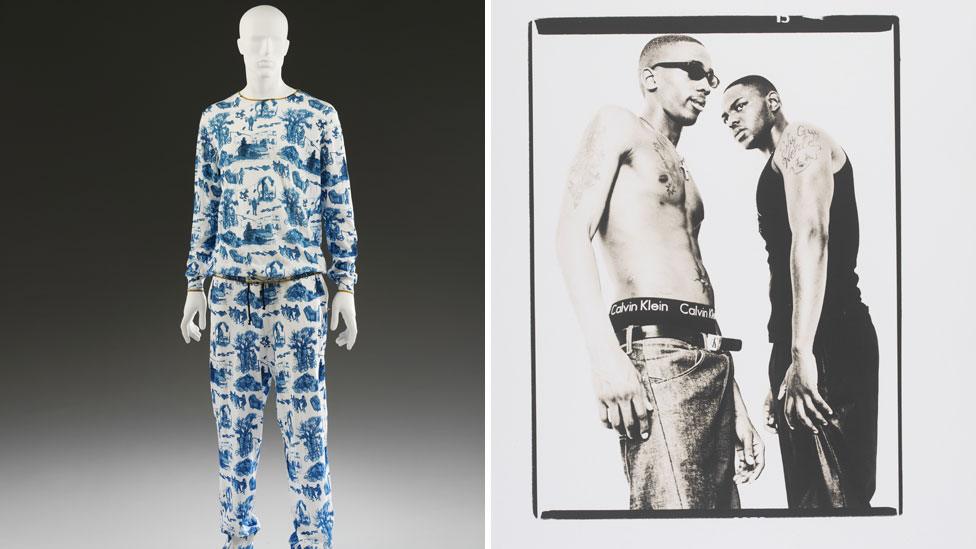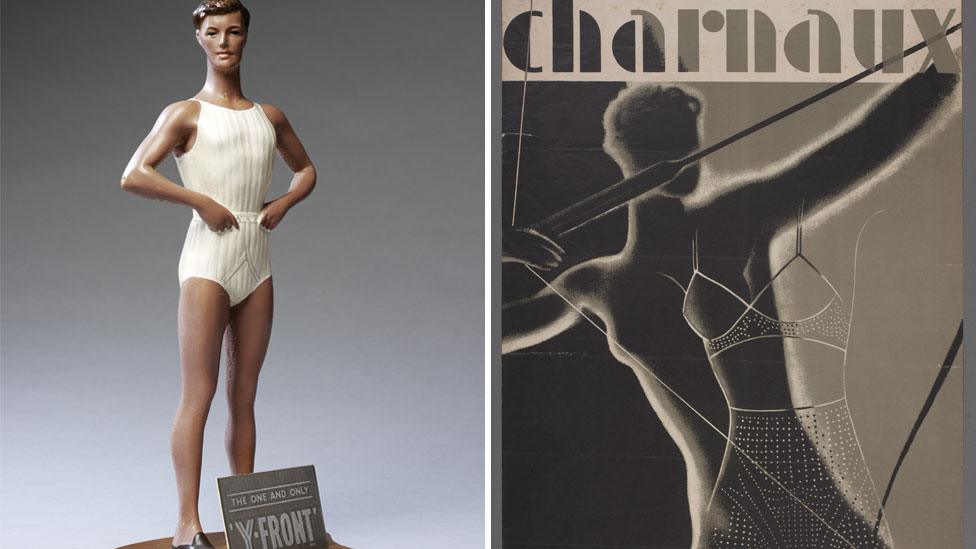Uncovering the history of pants
- Published

Corset 1890-1895/Everyday knickers
Ever since the Victoria and Albert Museum opened, textiles and how they're used has been a primary focus. But it's taken until now to organise a whole exhibition about underwear. The curator says more than any other clothing, underwear is a mix of the alluring and the utterly practical.
Many major exhibitions boast they contain items previously unseen by the public. Undressed, at the Victoria and Albert Museum, consists largely of clothing which once upon a time the V&A would have felt improper to show at all.
From the British "Keelapso" bustle of 1887 and the German "austerity corset" of the First World War to a 1970 bra made of beaten metal, the exhibition uses 200 objects to tell the story of underwear since about 1750. Women's fashion dominates but about a fifth of the show looks at what men wear underneath.
Curator Edwina Ehrman says gathering opinions about male underwear was tough.
"Generally men won't talk about underwear. It's significant that if you go into a department store the underwear for women will often be on hangers: women like to test out the stretch or investigate the stitching and check the shade against their own skin-tone.
"But men's underwear will be in a rigid, sealed box which features an attractive young guy with muscles. For men the transaction seems totally different."
Sign of gentility
Fortunately even the most delicate examples of women's underwear have survived the centuries remarkably intact. "We have a lovely hooped petticoat probably from the 1760s which is described as in the French style - though actually it comes from County Sligo in Ireland.
"Having something so finely made meant its well-to-do owner, a Miss O'Hara, was advertising her status and wealth. And it would have made her waist appear slimmer, which was a sign of gentility."

Man's top and pants, designed by Sibling 2013/Calvin Klein campaign Brixton Boyz by Jennie Baptiste 2001
Edwina Ehrman says the new exhibition has been especially dependent on the generosity of donors - though she admits she's still searching for a rare original Jogbra of the 1970s.
The arrival of the first bras at the beginning of the 20th Century is a major change documented in the show.
"Corsets had been worn throughout the 19th Century - and in fact before that, when they were known as stays. But by 1900 people were more aware that a highly constricting corset could be unhealthy for a woman. It interfered with breathing and put pressure on the internal organs.
"So from 1876 you get the first 'bust supporter' which then leads eventually to the bra. Its proponents, both men and women, saw it as creating a more natural female figure.
"The corset had essentially been there to displace flesh, both upwards toward the bust and downwards over the hips. It was often a difficult thing to wear but it's never lost favour entirely: support-wear certainly didn't disappear."
Blue girdle
Ehrman says quasi-medical concerns also led to the jock-strap, or athletic supporter, for men.
"Its existence was linked to the Victorian craze for cycling. Jock meant jockey but it had more to do with bicycles than with horses. There was a need to support the man's private parts as he rode along."
Another major shift the show investigates is the effect of Elastane, known usually as Lycra or Spandex.
"Lycra goes back further than most people imagine: it starts to become an influence in the very early 1960s," says Ehrman.
"One of my favourite pieces in the exhibition is a wonderful blue girdle from the British company Silhouette. It's made in Lycra and it was the work of a woman designer - as many of the items on display are."
The exhibition is laid out on two levels and the upstairs gallery deals in part with the sensual. Ehrman says the sexy and the practical have always existed side by side in women's underwear in particular.

Gwyneth Paltrow's Trompe L'oeil corset dress by Antonio Berardi 2009/Cage crinoline the Princess Luise Jupon Paten c1871
"I thought it would be dishonest to curate the exhibition without acknowledging the erotic side of underwear. So we have one big case which looks at role-play and fetish. We have a latex corset and knickers, custom-made for us by the company House of Harlot.
"It's underwear for people who enjoy the tactility and glossiness. In its silkiness it feels like flesh. It was the sort of thing young clubbers wore in London in the 1980s: but it's interesting that the same company also went on to supply mainstream fashion outlets.
"It's very theatrical and mainly there to be looked at and admired: it's actually quite complicated and time-consuming to get anyone out of it."
Male physique
Ehrman says it was mainly gay men who began to take male underwear beyond the basic.
"The influence of Calvin Klein is instructive. Their product was fashionable but it was fairly straightforward, well-made underwear.
"But the advertising and marketing emphasised the male form in a way new to the mass market. So in Britain even Marks and Spencer then produced highly form-fitting T-shirts and pants which emphasised the male physique in a way they wouldn't have done a few years earlier.
"A lot of research is going now into how men's underwear can emphasise the line of the body both above and below the waist. If you look at earlier pieces in the show they're often about compressing the man's genitals against the body to flatten the outline: now the opposite is true.

Y-fronts and matching vest c1950s/Advertising designed by Hans Schleger for the Charnaux Patent Corset c1936
"Of course if you went back well before the era we're covering you'd find the cod-piece, which did the same thing but in an even more obvious way."
Ehrman says it's difficult to know where fashion in underwear will go next.
"The exhibition shows change comes because technology moves on and because people want new ways to be alluring while staying comfortable. And young people want to wear something the previous generation did not. Society changes in all kinds of ways - but the interest in projecting femininity and masculinity does not go away"
Undressed: A Brief History of Underwear is at the V&A until 12 March 2017.